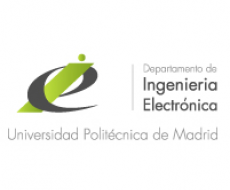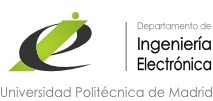Resultados Elecciones al Consejo de Departamento

Con fecha 13 de noviembre de 2012, se procede a la proclamación definitiva de los candidatos electos.
José Miguel Jiménez se jubiló.

El pasado día 29 de Octubre causó baja por jubilación nuestro compañero José Miguel Jiménez Pérez, Técnico Titulado de Laboratorio, quien ha venido colaborando con el Dpto. durante los últimos 33 años, con gran dedicación y abnegación.
Digital Electronic Systems (SEDG-3005)
This course is mainly focussed on the study of microprocessors/microcontrollers and their application in the design of electronic systems. It extends the study of digital circuits presented in the course Circuitos Electrónicos Digitales with a new type of systems: programmable systems.
After a review of the basic concepts of computer architecture presented in the course Fundamentos de los Ordenadores, this course is structured around a specific microcontroller, the Motorola ColdFire MCF5272, which is used as a reference to introduce the main aspects of any system based on this or any other microcontroller.
Both, hardware and software issues, are covered in the lectures, including hardware connections, peripherals, timing considerations, and interruptions, as well as assembler programming. Deep knowledge of all these issues is a requirement for the follow up course Laboratorio de Sistemas Electrónicos Digitales.
Introduction (1 hour): Course presentation.
Microrprocesor systems (3 hours): Components of a microprocessor system. The microprocessor market today.
Programming of the ColdFire family (10 hours): Assembler programming. The ColdFire programming model. The ColdFire instruction set: data. The Colfire instruction set: control.
ColdFire hardware architecture (8 hours): System architecture. External pins and signals. Memory system configuration.
Exceptions in the microprocessor system (8 hours): Exceptions. Interrupts. System protection and power management.
Input/Output in the microprocessor system (10 hours): Input/Output. Parallel Input/Output. Serial Input/Output.
Timer modules in the microprocessor system (8 hours): Programmable timers. Pulse width modulation.
Memories in a Microprocessor System (6 hours): VLSI memories. Dynamic memories.
Electronic Systems Engineering (ISEL)
The main objective of this course is:
* To know the theoretical background for the embedded systems design and implementation:
-> Hardware Architecture
-> Software Architecture
-> Framework design
-> Real systems
The contents that constitute this course are:
T1: Introduction and basic concepts (2h)
T2: Processor based system design:
General architecture (2h)
Interfaces (2h)
Memory hierarchy (2h)
T3: Microcontrollers for embedded systems
Basic architecture (2h)
PIC (2h)
AVR (2h)
T4: Embedded system programming (6h)
T5: Real time embedded systems (4h)
T6: Low power systems (2h)
T7: Reliability (4h)
T8: Design methodology (4h)
T9: Toolchains (4h)
T10: Ubiquitous computing (4h)
HISEL - Laboratorio de Electrónica de Alta Velocidad
Person-machine Dialogue Systems (SDPM 2)
This course is devoted to the study of the various modules involved in an interaction system or of human-machine dialog. Starting with an overview on dialogue systems and their problems, to go on to address the key modules that make it up, describing its operation, the research alterna-tives adopted to achieve optimal system performance and the problems of each.
Each of the modules will be started from a basic level and go up to describing the most ad-vanced algorithms and techniques with which we will get the most robust and reliable systems.
The course is based on lectures to acquire the desired skills, but it also includes a set of applica-tion case studies, specially selected, to be solved in common and that allow the application skills to be acquired.
This will enhance the interaction with the students so they can apply the acquired knowledge in a final project of the subject.
The course will be cover the following topics:
1. Dialogue system architecture
2. Fundamentals of production and Speech perception
3. Synthesis and generation of response
4. Speech recognition: parameterization and quantification
5. Speech recognition: hidden Markov models
6. Continuous speech recognition
7. Adaptation
8. Language models
9. Speaker identification and language identification
10. Speech understanding and translation
11. Synthesis and recognition of emotions and multimodal interaction
12. HTS synthesis
13. Design methodologies and user modeling
14. Evaluation of dialogue systems
EVALUATION PROCEDURE
Students complete the course with a final project of individual character to be presented publicly in English as part of activities to acquire transversal competences of documentation, communi-cation and publication.
The report must be presented in the typical format for IEEE conference papers (http://www.ieee.org/conferences_events/conferences/publishing/templates....) with aim of encouraging the student, not only through the reading and interpretation of scientific and tech-nical documents, but also its correct wording.
The final project must be eminently practical, and in it should be applied some of the tech-niques described in the course, preferably, a problem that may be related to research or pro-fessional activity of the student.
The written report will be the 70% of the final grade. However, the teacher also will observe the ability of students to communicate effectively and concisely the technical information, knowledge, justifications, etc. and to answer the questions he may pose them. The oral presen-tation will be the 30% of the grade.
Microelectronics Laboratory (LDIM 2)
The ultimate objective is the practical realization of a complete design of a relatively complex circuit using commercial CAD tools for full custom design, all of Cadence:
- Schematic editing. Analog simulation. Editing and synthesis paths: Virtuoso.
- Layout verification (DRC and LVS): Assura
- Parasitic extraction: QRC
The laboratory will be in pairs in the laboratory of Building B (B-043). Each pair is assigned a desk to choose between morning or afternoon. Each time slot is three hours.
Practical works:
- Week 1: Introduction to Cadence work environment. Design, simulation and characterization of an inverter schematic. Design, simulation and characterization of two cell diagram basic NAND, NOR of two inputs or similar.
- Week 2: Advanced characterization of circuits with the Analog Design Environment. Parameters. Calculator. Parametric simulations. Monte Carlo simulations. Corners simulations.
- Week 3: Editing paths, extraction and verification of operation. Inverter, NAND and NOR.
- Week 4: Sequential Circuits. Full custom design and characterization of recording media.
- Weeks 5 and 6: Design, simulation and characterization of a cell of average complexity (memory cell flip-flop, etc..).
- Weeks 7, 8, 9 and 10: Completing the final practice, design, simulation, characterization and delineation of a block design chosen as final practice.
Teaching methodology
The course will run for 10 weeks in laboratory sessions practical. During the first three weeks sessions will be preceded by a short talk introducing theoretical issues of the course and the practical demonstrations.
Practices to week 6 are guided, you can follow step by step practice notes at your disposal. At the end of each session, students will make a brief report to work.
The final practice developed between weeks 7 and 10 is free and is intended to complete the design (layout) and characterization of a circuit of moderate complexity. Be offered several topics, but also encourages students to delve into any design theme full custom analog, digital or mixed.
To justify the work done, the corresponding files will be delivered to paths and a document of 3 to 6 pages in IEEE Conference format (preferably in Latex) including at least the following points:
- Summary (Abstract): Concise summary of the work performed and results obtained.
- Introduction (Introduction): Introduction to the problems and how to solve the circuit has been previously decided in the scientific literature.
- Functional description of the design (Functional Description of the Design).
- Destaller implementation (Implementation Issues).
- Characterization (Characterization): including the explanation of the work environment, experiments and results of characterization. Optionally you can include a comparison with previous work.
- Conclusions (Conclusions).
- Bibliography
You can include all the figures that are deemed necessary to improve the explanations of the text. Optionally, the drafting of the report can be done in English (see section name in brackets). The work was presented orally to other colleagues at the end of the course. The exposure of each job will last 10 minutes approximate. In the talk should be involved two team members.
The technical quality and originality of the final practice account for 40%.
The quality of the oral presentation and the memory of the final practice contribute 20% of the grade.
The remaining 10% comes from the student's demonstrated skills in the use of the work environment along the course.
Microsystems and Nanoelectronics (MSIS+NANO 2)
Current electronic systems include, in increasing numbers, sensors, actuators and interfaces with the user which tend to be, in turn, real micro-and nanosystems (MS and NS). This is more relevant in portable systems where improved performance, the user interfaces and energy aspects are promoting the use of nanoelectronics technology even in the parts of uptake and storage of electrical energy. The smart phones are certainly a paradigm of such trends. Other examples of social relevance are occurring in the area of biomedicine. The commercial availability of so-called "lab-on-a-chip", true MS and NS that integrate aspects of nanosensors, MS and integrated intelligence and routinely used in hospitals analytical and sensory implant developments are promoting new advances in MS and NS.
From a content perspective, the educational objectives can be grouped into three main blocks:
- Understand and review an overview of micro and nanoelectronics (NE), from the point of view of current applications, this market, and the ongoing potential applications, with special emphasis on electronic systems.
- Study the principles of operation and manufacturing of Microsystems and Nanoelectronics in the areas listed above. In this context we introduce the basic principles of nanotechnology that are required.
- Study of the presence of MS, NS and NE in current electronic systems in four initial areas, smart mobile phone, communications, high-speed internet, biomedicine, and generation / energy storage. This will allow comparative knowledge of different types of micro-electro-mechanical, acoustic, optical, electro-optical and (bio) chemical, and submit the presence of NE in the processing circuitry and storage.
From the standpoint of aptitude, the objectives of this course are to develop the ability to reflect and relate contents, the search, preparation and presentation of information, and the integration of knowledge work.
This course consists of two interrelated parts. The first part is devoted to the study of the fundamentals nanoelectronic and functionality of the various types of micro / nano-electronic current. The second part deals with the identification and comparative analysis of micro / nano-and nanoelectronic elements currently on loa advanced electronic systems. The initial systems for the study refer to portable terminals, high-speed communications, energy capture and storage and biomedicine. In connection with this second part of the course, each student must make a personal studio and oral and written presentation on MS, NS and Now or NE, after the preofesor Guided definition in any of the current SE scopes have ineteres for the student ..
PART 1
1. Introduction to microsystems and background
2. Materials and manufacturing for microsystems
3. Physical microsystems: temperature, pressure, acoustic, inertial
4. Optical Microsystems: photodetectors and displays
5. Chemical and Biological Microsystems
6. Microsystems Market
7. Introduction to nanotechnology and nanoelectronics. Evolution and advanced devices in the ICT area.
8. Materials and structures for nanoelectronics and their properties in that scale.
9. Nanoelectronic devices and nanooptoelectrónicos
10. Other nanostructures for ICT and energy.
PART 2
Functional study and comparative analysis of the presence of MS, NS and NE in
• Smart Phones
• High-speed communications
• Biomedicine
• Collection and storage of energy
Teaching methodology
This subject will be taught through classes and activities outside of class (study and work and team). Students complete their training with a single character work to be presented to their peers as part of the course evaluable. In addition, some invited lectures will be taught by professors and researchers from other centers on relevant topics related to the subject. Also, students will be offered optional visits to other research centers.
Evaluation description, displaying the weight of each test.
The evaluation will consist of testing (50% of score), along with exposure of individual work by students, on a topic agreed in advance with the teachers, or other homework (40%). They also account for students' active participation in the sessions and discussion forums (10%).
Advanced Materials for Microelectronics (MAMI)
El objetivo de la asignatura es que los estudiantes adquieran un conocimiento básico de los fundamentos de la física del estado sólido aplicados a materiales electrónicos, y de las propiedades electrónicas y ópticas de los semiconductores. La asignatura culmina con la aplicación de dichas propiedades a distintos dispositivos micro y optoelectrónicos, con énfasis en los aspectos del material.
Esta asignatura resulta fundamental para los siguientes objetivos del título:
Obj 1. Conocer y comprender los fundamentos científicos del mundo de los materiales y sus interrelaciones entre la estructura, propiedades, procesado y aplicaciones.
Obj 3. Conocer el comportamiento mecánico, electrónico, químico y biológico de los materiales y saber aplicarlo al diseño, cálculo y modelización de los aspectos de elementos, componentes y equipos.
Ficha de Asignatura: Propiedades de materiales I
Contenidos y Distribución de Tiempo Docente
(LM: Lección Magistral, RP: Resolución de Problemas, LB: Laboratorio, TI: Trabajo Individual, TG: Trabajo en
Grupo, DB: Debate en Aula, VI: Visitas, EV: Pruebas y Evaluaciones, OT: Otros Procedimientos)
Se relacionan a continuación los contenidos de la asignatura y la distribución temporal de su impartición.
La docencia presencial se divide en lecciones magistrales de teoría y problemas (LM), resolución dirigida de
problemas (RP), y pruebas de de evaluación (EV). Habrá también una prueba de evaluación final.
Los alumnos realizarán varios trabajos individuales (TI) y al menos un trabajo en grupo (TG).
Tema Tema (LM) RP EV Trabajo
1
Introducción (1 h)
- Presentación.
- Aplicaciones de los semiconductores: Microelectrónica y
Optoelectrónica.
2
Conceptos básicos de Ciencias de Materiales (4 h)
- Tipos de enlaces en sólidos. Estructura cristalina. Defectos
cristalinos. Crecimiento Czochralski. 1h
TI-1
3
Conducción Eléctrica en Sólidos (6 h)
- Teoría clásica: modelo de Drude y resistividad. Regla de
Matthiessen. Efecto Hall. Conducción eléctrica en
semiconductores y no metales.
2h
TI-2
4
Teorías de Sólidos (10 h)
- Teoría de orbitales moleculares. Teoría de bandas en sólidos.
Masa efectiva en semiconductores. Densidad de estados.
Distribuciones estadísticas de partículas: Boltzman vs. Fermi-
Dirac. Teoría cuántica de metales. Energía de Fermi. Emisión
termoiónica y dispositivos de tubos de vacío. Fonones.
2h
TI-3
- Evaluación parcial
2 h
5
Materiales Semiconductores (9 h)
- Semiconductores intrínsecos y extrínsecos. Dopaje.
Conductividad y temperatura. Recombinación de portadores.
Ecuaciones de conducción y difusión. Ecuaciones de continuidad.
Absorción óptica. Piezoresistividad.
3h
TI-4
6
Dispositivos Semiconductores (9 h)
- Contacto óhmico y Schottky. El diodo Schottky. Enfriadores
termoeléctricos. La unión p-n. Polarización en directa e inversa.
Curvas I-V. Introducción a dispositivos electrónicos: transistores
bipolares y de efecto campo. Introducción a dispositivos
optoelectrónicos: fotodetectores, diodos emisores de luz, células
solares.
2h
TI-5
- Evaluación final 3h



